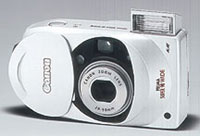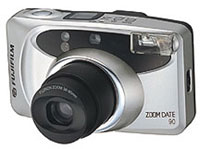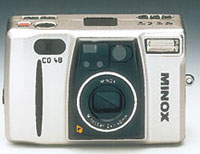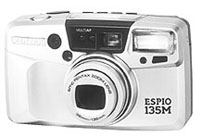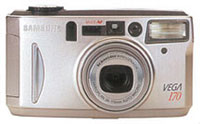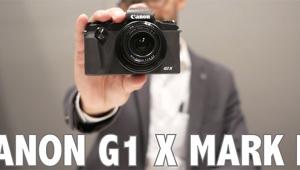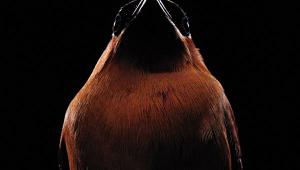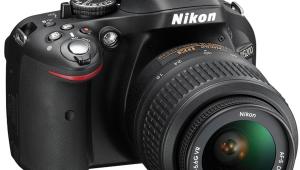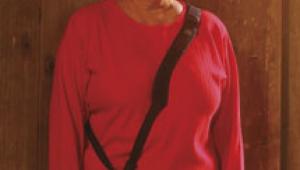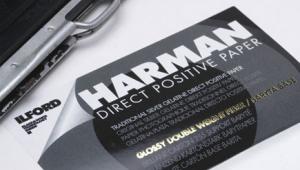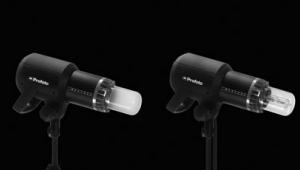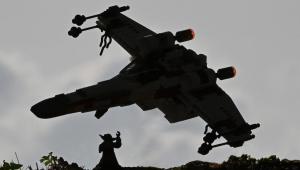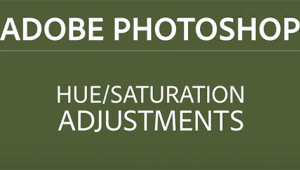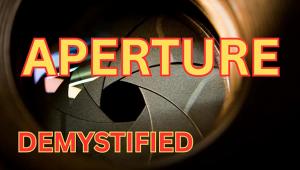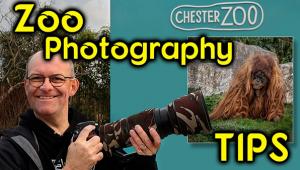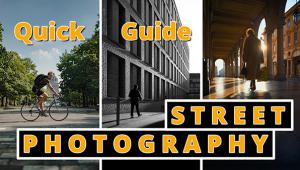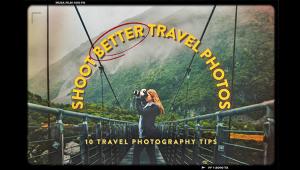New 35mm And APS Compact Cameras
Since the compact lens/shutter cameras still outsell SLR models by a vast margin, we found numerous new models at photokina. Most manufacturers offer both formats: 35mm and Advanced Photo System (APS or 24mm). Because general features tend to be very similar in both types of cameras, I am including both in this report. Naturally, APS offers some extra benefits such as Print Quality Information Exchange (PQ ix); pre-selectable image formats; convenient Mid-Roll Change (MRC) capability with some cameras; and so on. Where this is particularly relevant, it will be mentioned in this report. Do note that photokina is considered to be a European trade show, so product photos often bear foreign model names. However, in my comments, I'll always refer to the cameras by their US designation. Many of the lens/shutter models have long lists of specifications; lack of space prevents me from listing all of the features. If a new model seems to be of particular interest, do ask your photo retailer or the distributor for a full brochure; in most cases, specs are also available on the web sites of manufacturers and some mail-order companies. Canon. Although the Canon Press kit refers to Prima 35mm compact Prima cameras, these models will be called Sure Shot in the US. We especially liked the Sure Shot Z90W (Prima Super 90 Wide), billed as "the world's smallest fully automatic wide angle camera in its class" at the time. It has an attractive silver finish and a 28-90mm f/4.5-9.9 zoom and a simple Best Shot dial on the back. The latter features seven settings, making it easy to select and store a preferred camera setting. The three-point ADF system includes both active and passive AF for maximum reliability. Other features include a real image zoom finder; eyepiece diopter adjustment; multimode flash; and exposure compensation control. At wide angle, shutter speeds from a very fast 1/640 sec to 2 sec are available, reducing to 1/350 sec to 2 sec at telephoto. Canon has also expanded the very affordable Sure Shot Owl series with the Owl PF and Owl BF. Both sport an extra large viewfinder with long-eye relief, ideal for those who wear eyeglasses while shooting. Built-in flash with a few modes, mid roll rewind, and an attractive white fold finish make these cameras simple and attractive. The Owl PF has a 35mm f/3.8 active autofocus lens while the more affordable Owl BF comes with a 32mm f/5.6 fixed focus lens. |
||
Concord And Keystone. Said to be the world's largest manufacturer of compact cameras for other companies, Concord is also marketing some models: Le Clic by Keystone, focus-free Critter and Crayola cameras for children, and some under the Concord logo. The Le Clic line includes many translucent cameras in several colors, reminiscent of iMac computers. The Concord reps showed four new Keystone 35mm models. The K1800 is an autofocus 35-63mm zoom camera with macro mode (2' minimum focus), flash, and the usual basic amenities. The K2000 and K2001 feature a 35-70mm "razor sharp" lens, multi-zone active autofocus, versatile flash (especially the K2001), and LCD panel as extras. The K2001 also has a macro mode. The top model K3000 boasts a 38-115mm zoom plus super-macro mode, all-glass lens, and a more versatile flash system plus exposure compensation. |
||
In the APS Le Clic line, Concord showed off two new models: the Le Clic LC 300 Autofocus and LC 250 fixed focus automatic cameras. Said to be the smallest on the market at the time, they are available in metallic silver embossed finish with leatherette trim at an affordable price. Full specs were not yet available but these cameras include flash, motorized film handling, and simplicity of use. |
||
Fujifilm. During our visit to Fuji's huge photokina office, we saw a half dozen brand-new compact cameras, both Nexia APS and 35mm. However, some of these models may not be imported into the US and may have different features. We'll report on those after the PMA show in February 2001, if they are announced at that time. The Discovery Zoom Date 90 and 120 are similar cameras, both featuring the new Sure Loading system for easier loading and pre-winding to protect exposed pictures if the camera back is accidentally opened. These models feature real image zoom finder; active autofocus; multimode flash; large LCD panel; and date/time imprinting. Zoom Date 90 sports a 38-90mm f/6.7-f/9.8 Fujinon zoom while Zoom Date 120 offers greater reach with its 38-120mm f/6.7-12.7 lens. |
||
Kalimar. Recently acquired by The Tiffen Company, Kalimar showed an incredible number of new models at photokina including the Barbie 35mm and 110 series for children; these will be hot sellers in December. Kalimar also offers several semitransparent, colorful I-35 focus-free cameras in the $10-$20 range plus Superview 35 models with a 200 percent larger viewfinder at a moderate price. Their Precision Zoom 35mm cameras are focus free, too, but include a 35-55mm zoom, motorized film handling, and flash for under $50. If you're looking for budget-priced cameras to give as gifts, do check out the Kalimar line. |
||
Kodak. A prolific manufacturer of compact cameras, Kodak demonstrated several new models. Their Advantix Preview APS camera received the greatest attention because of the 1.8" preview screen LCD display on its back. After taking a picture, you can preview what the print will look like, including the probable exposure; if you don't like what you see, simply re-shoot the picture. You can also press a button to tell the camera (and the photofinisher) that you want no prints of certain pictures or that you want more than one print of favorites on the roll. The preview image is digital, but this is a conventional film-based APS camera with 25-65mm f/4.3-10.4 zoom, multimode flash, PQ ix and MRC, and title printing. The new Advantix C850 is a more conventional APS model with sophisticated 220-step autofocus; AF assist lamp; a superb 27-80mm f/5.6-8.6 zoom lens with aspheric elements; incredibly versatile flip-up flash; 1/2 to 1/300 sec shutter speeds; advanced PQ ix and MRC; print titling; and more. We really liked the large "interactive" LCD data panel on the back; this replaces symbols with plain text messages. This mid-priced model will be available in April 2001. We checked out a few low-priced APS cameras, too: the Advantix C350 (fixed focus) and C450AF plus the price-leader Advantix F320. (All will be available in April 2001.) The latter is completely automatic for true point-and-shoot simplicity but will include a self-timer, film rewind motor, and 13' flash range with ISO 200 film. The C350 and C450 are similar and will replace the C300 and C400 models. They include flip-up flash with several modes and 13' range with ISO 200 film; an all-glass 25mm f/5.6 lens; 1/90-1/250 sec shutter speed; and safety film door lock. PQ ix and MRC are not available. The C450AF offers extra close focusing to a mere 2.6' and two-zone autofocus so it's the more desirable of the two cameras. Kodak's new 35mm series of KE 35 compact cameras all include a new Easy Load technology for foolproof loading. The latest model is the KE 85 Zoom with 38-85mm f/3.8-8.5 high-grade lens; 31-zone autofocus; 4-1/500 sec shutter; multimode flash; and safety lock to prevent opening the film chamber in mid roll. It also offers an interesting new feature: In-The-Picture Indicator for use with the self-timer. If you can see the red bulb on the camera, everyone in a group shot will be in the picture. This model plus a similar KE 115 (not yet exhibited) with 3x zoom lens will be available in April. |
||
Konica. This manufacturer demonstrated five new cameras starting with their latest APS model the Revio II with stylish ribbed aluminum body housing a 23-50mm f/3.9-7.9 zoom. The specs list is long and includes: MRC; 1-1/500 sec shutter; real image zoom finder; illuminated LCD panel; +1.5 exposure compensation button for backlighting; multimode flash; date and title imprinting; and autofocus from 1.6' to infinity. A specially designed mirror adapter makes switching to self-portrait mode easier than with previous models. A new flash power management system helps extend battery life by up to 50 percent. At the other end of the price range is the low priced, fixed-focus 35mm model the Zoom FX50 with 35-52mm f/6.3-9.4 zoom and three flash settings. Another budget-priced model, the Big Mini BM-21 is made for pure simplicity with 30mm f/4.5 lens, autofocus, and several flash modes. The mid-priced autofocus Z-up 70 VP with 35-70mm f/5.2-9.8 offers a few more extras. These include extended battery life technology, real image zoom finder, multimode flash, and +1.5EV exposure compensation. Konica also introduced a new series called Lexio; the US name may be different. Said to be "the smallest and lightest 35mm zoom compact camera" at the time, this model features a slim aluminum body with 28-70mm f/3.4-7.9 and capabilities borrowed from the Z-up 70 VP. |
||
Leica. A conservative manufacturer, Leica did not have an APS format camera until now. At photokina, they showed off the new C11 in a lightweight aluminum body with an aspheric seven element 23-70mm f/4.8-9.5 zoom. Making use of the advantages of APS technology, the C11 features basic PQ ix and MRC; autofocus; multimode flash; 1 to 1/600 sec shutter; real image finder; LCD data panel; and AE Lock. Close-focusing ability is 2'. This great looking camera, with an elegant look and feel, will be available in black and in silver finish. Minolta. This year, Minolta concentrated on engineering a new SLR camera, new D-series lenses, and two flash units, so it showed only one compact camera. The Freedom Zoom 150 (call-ed Riva in Europe) features a 37.5-150mm f/5.4-11.9 zoom--with four aspheric surfaces--in a surprisingly compact size. Wide area passive autofocus makes off-center compositions quick and automatic while Backlight Compensation (+1.5EV) helps prevent underexposure with subjects of high reflectance. The flash offers many modes for maximum versatility. |
||
Minox. This manufacturer brought two brand-new models to photokina, a 35mm and an APS compact camera. Their CD 48 APS model features a robust high-grade metal body for durability and a high-resolution six element 24-48mm zoom lens. Active autofocus as close as 2.6', multimode program flash, and motorized film transport plus MRC round out the specs. The Minox CD 128 is a 35mm autofocus camera, with excellent 38-128mm zoom and multimode flash. Nikon. Upgrading their
Nuvis line of APS cameras, Nikon showed us the new Nuvis V, a gorgeous
black and silver autofocus model with distinctive red trim. This is a
full-featured model with 22.5-66mm zoom with two aspherical elements for
high definition images. It's a fairly "fast" lens, too, at f/5.2-7.7.
This is a wide-area passive autofocus camera with close focusing down
to 1.5' plus date and title imprinting; MRC and PQ ix; multimode flash;
eyepiece diopter adjustment; real image zoom finder; and more. |
||
Olympus. The entire press kit was oriented for the European media, but an Olympus U.S.A. rep advised me that some of the new cameras will bear more familiar logos in North America. (Release date: spring 2001.) He showed an entirely new series with the first camera to be called View Zoom 120 with a 38-120mm f/3.7-10.8 autofocus lens. The most significant feature of this new series will be a completely enhanced viewfinder that's 60 percent larger than on conventional models. Flash and the usual modes will be standard equipment. Called u[mju:] in many countries, the Stylus cameras are said to be the most popular series in the world. The latest Stylus Epic Zoom 115 Deluxe will be a fully equipped model with 38-115mm f/4.6-10.9 zoom with two aspherical elements. Its improved real image zoom viewfinder is 76 percent brighter than on the previous model. Passive multi-point autofocus, real zoom finder, and many flash modes will be included. Weatherproof construction, three segment light meter plus spot metering will ensure the continued success of the Stylus Epic line. The latest Olympus APS camera will be called the i200AF around the globe and it's an attractive model with metal front plate and silver finish. It will be equipped with a 24mm f/4.5 autofocus lens, PQ ix, flash with several modes, and more. |
||
Pentax. Pentax markets its 35mm models as Espio in other countries, so their product photos showed the Espio badge. Do note that these will be sold as IQ zoom cameras in the US although the exact model designation was not certain in October. I checked out three brand-new Zoom models. The smallest (shirt-pocket size) was the IQ Zoom 70S (Espio 738S) with autofocus 38-70mm f/4.8-8.5 zoom, with four settings: 38mm, 50mm, 60mm, and 70mm. It's coupled with a real image zoom finder, multimode flash, and simple automatic operation. Backlight compensation (+1.5EV) and a large, easy to read LCD panel are the only extras in this affordable model. A similar model, the IQ Zoom 80S (Espio 838S) also features a power step zoom with four settings: 38mm, 55mm, 65mm, and 80mm. At a higher price the IQ Zoom 135M will deliver greater sophistication with passive five-point autofocus and selectable spot focus, too. Six-segment exposure metering assures excellent results, while the high-performance 38-135mm true zoom lens includes a macro setting (minimum focus from 2.6 to 3.6'). The multifunction flash is quite sophisticated and there's a zooming viewfinder plus eyepiece diopter adjustment switch. Unlike most 35mm cameras, this one can be switched to panorama frame and in mid roll. The newest Pentax autofocus APS camera, called the efinaJ worldwide, is a compact model with 24-88mm f/4.9-9.6 zoom plus zooming viewfinder. There's a large, easy to read LCD panel, PQ xi and date plus title imprinting, and built-in flash with several modes. Note that imprinting can be set for the front or back of the print. |
||
Rollei. No longer affiliated with Samsung, Rollei USA now has new owners and a new address. Their president Jeff Karp showed me their two most recent models: the Prego Zoom 125AF and Prego Zoom 140AF. These boast Rollei Vario Apogon lenses, 38-125mm and 38-140mm respectively. Almost identical in many respects, both feature passive autofocus systems; backlight compensation (+1.5EV) buttons; zooming viewfinder; flash with several modes; panorama frame option; close-focus capability; diopter correction eyepiece; and large LCD panel. These are beautifully built and finished cameras in elegant metal housings with premium grade lenses and offer great value for the moderately high price. |
||
Samsung. This manufacturer offers numerous compact cameras, with the very latest being the Evoka Zoom 170 (called Vega in product photos) in a silver aluminum casing. This model boasts a Schneider-Kreuznach 38-170mm f/4.7- 13.5 aspheric zoom for high image quality and extended reach at the long end. Other features include a real image zoom finder; multimode flash; passive multi-zone autofocus system plus spot AF; diopter adjustment eyepiece; and automatic portrait zoom mode. The more affordable new model is the Maxima 120 Super Zoom (called Fino Super 120 in Europe). This one has a high tech look with silver aluminum shell and a jog-shuttle control on the back. The Samsung 38-120mm f/4.5-13.1 zoom is coupled to a real image zoom finder. Active autofocus, multimode flash, automatic portrait zoom, 1/3-1/400 sec shutter, and close focusing to 2.6' make it a versatile model. |
||
Sea & Sea. Surprisingly affordable, the new Sea & Sea MX-5 model is completely automatic and features a 28mm f/9 focus-free lens, fixed shutter speed of 1/100 sec motorized film handling, sports finder, and built-in flash. It even offers a digital LCD window with useful information. You can take this camera snorkeling (down to 100'), boating, or out in rain or snow. |
||
SeaLife. The president of Pioneer Research showed me their new compact land/sea camera kit, the ReefMaster RC with external flash unit, attachable close-up lens, underwater filter, and more. Waterproof to 164', this camera sports an oversized sports finder and shutter release plus special coral flash to counter the blue caste underwater. This is an automatic model that can be used above water, too, when removed from its housing. The external flash unit with flexible arm will be appreciated by divers because it can reduce annoying backscatter. |
||
Vivitar. Recently, Vivitar has begun to aggressively expand its line of compact cameras, with the introduction of numerous new models at photokina. Specifica-tions were not complete for some of these models, so this summary is not comprehensive. The simplest Vivitar models--the colorful 35mm KidZcam--seemed to attract the most media attention. Children will love this focus-free model with 27mm f/9.5 lens, flash with redeye reduction, and total simplicity. Available in blueberry, strawberry, lime, and grape finish, these are highly affordable and show the internal mechanisms through a transparent shell. The CV 40 is a similar 35mm transparent model with focus-free 28mm f/8.5 lens plus flash; it's available in blueberry, strawberry, lime, and grape finish. The affordable APS model CV 24--in semitransparent blue--features a 27mm f/6.3 focus-free lens, motorized film handling, and built-in flash. In the more advanced 35mm category, Vivitar demonstrated the PZ3105 packed full of automation and creative controls. The 38-110mm zoom offers autofocus with 56 steps and there's a backlight compensation control, multimode flash, full information data panel, and more. They also provided a photo of a new 540MZ with 38-115mm zoom and a Series J lens but no additional specifics. In the affordable 35mm category, they showed the Mega Zoom 200 with a 35-50mm zoom with zooming viewfinder, flash with a few modes, and backlight control. The Mega 100s is nearly identical but has a 35-70mm zoom lens. The US rep also had information on several low-priced cameras, but not full specs, including the XM325 APS model and the T101 and T201 35mm cameras. The latter have 28mm f/9 focus-free lenses and fixed shutter speed of 1/100 sec. The rep also mentioned the splashproof WP35 with oversized finder and 28mm f/5.6 focus-free lens. Manufacturers/Distributors |
- Log in or register to post comments
